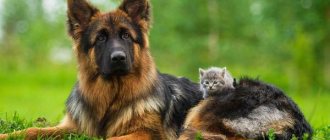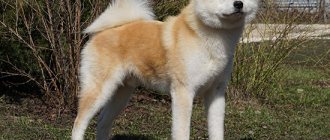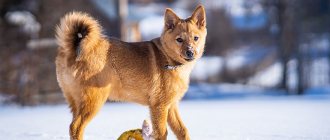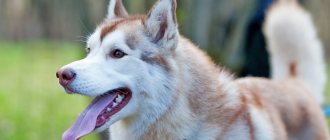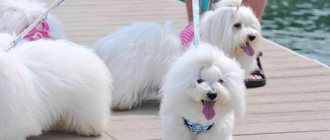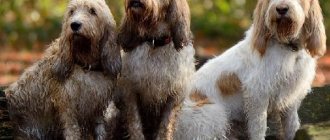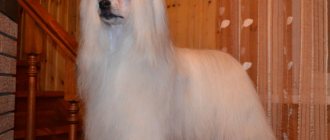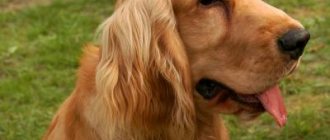Video
* We invite you to watch a video about the Japanese Spitz . In fact, in front of you is a playlist in which you can select and watch any of 20 videos about a given dog breed by simply clicking on the button in the upper right corner of the window. In addition, the material contains quite a lot of photos. By looking at them you can find out what a Japanese Spitz looks like.
In this article:
|
Rate the material!
[Total votes: 1 Average: 5]
Small fluffy Spitz dogs are at the peak of their popularity today. They are very beautiful, attract the glances of passers-by, and have a perky character. Such a pet will not leave anyone indifferent! However, few people know that there are many varieties of Spitz, each of which has its own characteristics, both in character and in appearance. This article examines a detailed description of one of the most prominent representatives of fluffy dogs - the Japanese Spitz .
Owner reviews about the breed
In the vast majority of cases, reviews about the breed are positive. The exceptional devotion of the Japanese, his kind, playful temperament and, at the same time, restrained, intelligent behavior towards children, strangers, and other pets living in the apartment are noted.
Paul. The Japanese is a very friendly breed, great for people who lack good emotions. He doesn’t like to be bored - he will always come to chat if you suddenly left him alone. Contrary to popular belief, maintaining the coat in its original form is not difficult - regular brushing and rare bathing. If he suddenly falls around, first wait until he dries, and only then give him a bath. When it starts to shed, carefully comb out the fluff for 1-2 weeks, and everything will be fine.
Natalia. Our Spitz is already 6 years old, but he is still cheerful and delights us with his eyes. The breed is very interesting - on the one hand, a cheerful miniature dog. On the other hand, he is clearly not from the category of pocket dogs. That is, such a reasonable combination of its kind. By the way, don’t let him sleep on the sofa like a cat - he may take a fancy to his place, and then it will be quite difficult to win it back. It is better to provide soft bedding in any corner - after all, he will still most often spend time with his family.
In the video, the owner of a Japanese Spitz tells everything about keeping this breed.
Thus, the Japanese Spitz is a breed of domestic dwarf dogs, which, nevertheless, are distinguished by courage and restraint. The pet will get along well in a family with children, and will also make a cheerful company for lonely people who need communication and attention.
The ideal family pet is the Japanese Spitz. No, this is not a cliché or a label, this is the goal set for Japanese breeders in the 19th century. The project was a success, but more on that below. The cute, snow-white, fluffy dog conquered his homeland and became a fairly famous dog in the world canine world.
This is interesting! The second official name of the breed is Nihon Supittsu.
History of the origin of Japanese Spitz
Active, cheerful, friendly, brave and beautiful - this is what most characterizes the Japanese Spitz dog breed. The history of this breed begins in 1920.
Its origin is associated both with other Spitz-type breeds and with Samoyed huskies. This last statement is often controversial. However, it is impossible to completely refute the close relationship between Spitz and Samoyeds, because northern dogs are relatives of many modern breeds.
The Japanese Spitz is a common breed. Its existence is recognized by all major canine organizations. The only exception is the American Kennel Club. Its representatives do not recognize the existence of this breed. They found a lot of similarities between the Japanese Spitz and the Eskimo dog.
The Japanese Spitz was first bred in Japan between 1920 and 1930. At that time, the German Spitz, which had just been imported, was at the peak of popularity in the state. It is the German Spitz that is called the ancestor of this breed. After its appearance in Japan, breeders began work on breeding a similar dog.
Through long work, small, fluffy white dogs were born. These dogs received recognition from the Cynological Federation only in 1964.
Origin of the breed
The ancestors of the “Japanese” are considered to be the German Spitz or the short Samoyed husky.
The first representatives of the breed were shown at an exhibition in Tokyo in 1921. Breeders devoted the next 10 years to the new breed. To improve it, white dogs of the Spitz family were crossed, which were brought to Japan from all over the world. The final stage was crossing with the American Eskimo Spitz.
In 1948, the Japanese Kennel Club adopted a breed standard. Two years later, elegant fluffies gained popularity. But international recognition came to them only 14 years later.
Japanese Spitz - description of the breed
The Japanese Spitz is rightfully called one of the most loyal, friendly dogs. This is a real comrade, companion. The Japanese Spitz is a rather small toy dog that is descended from the Samoyed. Sometimes this breed is called dwarf.
However, this does not entirely correspond to reality. Spitz dogs from Japan are much larger than dwarf breeds. According to the standard, Japanese Spitz dogs do not have a “mini” appearance. All dogs are at least thirty centimeters high. In addition, the Japanese Spitz has other characteristic external parameters.
Him:
- Light weight. This parameter is not regulated by the standard. Dogs of different weights are allowed. However, most often the weight is very small - from five to eight kilograms. At the same time, males are always larger, and females are more refined;
- Thin lips, neat nose. The lips have a black edging, so the Spitz looks like a fox. The nose is also pigmented black;
- Narrow, slightly elongated head. Japanese Spitz have a wide nape and a wide forehead. Externally, the shape of the head is very similar to that of a fox;
- Almond-shaped eyes. The dog's eyes are medium-sized, slightly slanted. The animal's gaze is always kind and very interested. The color of the iris is black;
- Strong teeth. These babies have a great grip. Their teeth, although small, are strong and sharp. The animal has a scissor bite;
- Triangular ears. Small Spitz dogs have a cute appearance. This is also due to the triangular ears. Small ears are surrounded by thick fur and are located high on the head. If the Japanese Spitz is excited, the ears tilt slightly towards the muzzle;
- Smooth, strong and flexible legs. The paws have a round shape and arched toes. Claws are dark in color;
- Fluffy tail. It is placed high on the back. According to the standard, in Japanese Spitz dogs it should not curl into a ring.
Appearance
Let us immediately note that the popular name of the breed, Japanese Dwarf Spitz, slightly understates the truth. A dog is not a pocket or bag option, it is a full-fledged companion, strong, nimble, flexible, and highly trainable.
Despite the convincing advertising campaigns of enterprising sellers, there is no mini variety; the size of an adult dog is approved by the standard - height from 30 to 38 cm.
The weight is not fixed by the description of the breed, the average figures range from 5–8 kg, but even a 10-kilogram “mini dog” (without excess weight) will be recognized as a breed if it meets the requirements of the standard. Typically, females are slightly more compact than males and differ in their “face features.”
Breed standard
- The head is of a typical Spitz shape: a wide nape, a moderately convex and spacious forehead, a well-defined transition to the muzzle without a “fracture.” The facial part narrows from the transition to the nose, looks pointed and neatly rounded. The lips are close-fitting, with a black edging. The shape of the muzzle and the color of the outer lines of the lips form the smile, which is a distinctive feature of the breed.
- Teeth are in a tight, correct bite and complete set.
- The nose is neat, sensitive, small, painted black.
- The eyes are small, slightly slanted, almond-shaped with a lively and friendly expression. The color of the eye shells is as dark as possible, the standard is black - the pupil is indistinguishable against the background of the iris. The eyelids are tight-fitting and black.
- Ears are set high, not wide, turned forward, and when excited, slightly inclined towards the muzzle. Triangular, medium in size, but looks small against the fluffy fur.
- Body - regardless of gender, the ratio of height at the withers to the length from the shoulder girdle to the extreme point of the croup should be as close as possible to the proportion of 10:11. The neck is of proportional length with a clearly visible bend and well-developed muscles. The withers are developed, flowing into broad shoulders and a straight back. The loin is quite wide, the croup is well sloping. The sternum is of standard proportions, developed, oval, deep to the elbow joints. The groins are toned, but the “undermining” is hidden by the fur.
- Limbs are straight with strong and flexible joints. The shoulder blades are pulled back, the shoulders are also rejected, the forearms are set vertically, the elbows are pressed to the body. The hind legs continue the sloping line of the hip, are placed under the body, and in the stance are wider than the front legs. The hands are round, collected, fingers are arched, selected. The pads are strong, fleshy, black. The claws are black.
- Tail - set high, carried over the back and pressed, should not be wrapped in a ring, but can be lowered and pressed to the thigh.
Coat type and color
The Japanese Spitz is exclusively white in color. Markings, iridescence, peach or gray tint are flaws. The undercoat is not too thick, but very dense and soft, supporting the guard. The coat is smooth, vertical, and dense. On the muzzle, ears and lower parts of the paws the spine is slightly shorter. The collar, frill, trousers and tail are dressed especially richly.
Note! Red color is not included in the Japanese Spitz standard. The “evidence” shown in the photo is German Spitz (similar in size and can be red) or Pomeranian (up to 20 cm at the withers).
Popular colors of Japanese Spitz
One of the most important characteristics is the quality of the coat and its color. The Japanese Spitz has an excellent coat. These are fluffy, cute dogs. It may seem that behind the fur of this animal there is a thin body. However, it is not. The luxurious coat of the Spitz hides a muscular, strong body. Males are stockier, females are graceful. Therefore, females are easy to distinguish from “boys”.
Unlike other types of Spitz, the Japanese has only one acceptable coat color - white. Because of this color, these fluffy dogs resemble small northern bears. Snow-white coat is the calling card of Japanese Spitz. Any other colors are unacceptable in this breed. Also signs of marriage are the following: ears that are not erect, a tail that lies directly to the back.
The purebred Japanese Spitz has a coat that is very soft to the touch. The hair is straight and rises high above the body. These dogs have an undercoat. It is not so much thick as it is voluminous. Also painted white. The hair is quite long throughout the body. Short hair covers only the ears, muzzle and front part of the animal's body. Sometimes on sale you can see Japanese Spitz dogs with a white color, but with various markings on the coat of a different color. This is a serious drawback. These dogs are not purebred.
White wool has a stunning, attractive appearance. However, it scares some people. They think that these dogs will have to be washed constantly. However, it is not. Japanese Spitz practically do not get dirty. They are neat, and their fur does not absorb dirt. To regain a well-groomed appearance, such a dog just needs to shake himself off after a walk.
How to choose a puppy
Japanese Spitz are a very popular and sought after breed. Buying a purebred puppy is not so easy and you need to do it in a specialized nursery with a good reputation, and not on the market. The breeder will provide the buyer with a purchase and sale agreement, puppy birth certificate and other documents certifying the purebred of the puppy.
Prices for Spitz dogs start from 30,000 rubles. The higher the exterior class, the higher the cost.
Purebred babies should have a snow-white coat, dark button eyes and neat erect ears. You can take home a fluffy ball at 1.5-2 months.
Character and habits of Japanese Spitz
There is still heated debate about the origin of the Japanese Spitz. Some consider them to be relatives of Samoyeds, while other experts are sure that the breed originated from the German Spitz. One way or another, these dogs have qualities of both breeds.
Spitz are incredibly cheerful, friendly and active. They are able to play for hours with children or their owner. They definitely got this character trait from their German Spitz. Despite their cheerful disposition, Japanese Spitz dogs can also be serious. They are reliable companions and excellent guards, which is undoubtedly a quality of Samoyeds.
Interesting fact: Japanese Spitz have an easy-going nature. Their breed is characterized by silence. However, in case of danger, the Spitz will definitely start barking, which can scare away the thief or draw the attention of its owners.
This dog is an excellent option for older people and children. She is obedient and does not require too much attention. The Japanese Spitz can be taught basic commands quickly and easily.
The most important thing when training is to maintain the golden mean. Don't be very strict or very affectionate towards your pet. The dog will obey its owner unquestioningly if he shows the animal his place from the very beginning. Like other dogs, Japanese Spitz dogs may try to dominate the family.
Spitz has a good disposition. He will be able to quickly find a common language with every family member, be it a small child or an elderly person. In addition, such a dog will not quarrel with other animals that live in the family. She will be able to get along with hamsters, rabbits and even cats.
Content
The Spitz is adapted for life in a city apartment - with its compact size, it has enough space even in a standard one-room apartment. But he, like any dog, needs active walks to release pent-up energy.
Need for physical activity
Walk the Japanese Spitz twice a day, one walk is at least an hour. It is important to find a quiet place where the dog can be let off the leash.
Spitz pregnancy is easy, so walks are not reduced until the last two weeks. Closer to giving birth, the bitch herself does not want to be outside for a long time - she quickly gets tired and refuses to be active.
Appearance care
The snow-white coat of the Japanese Spitz does not smell, but requires systematic care. Once a week, the dog needs to be combed, sequentially taking apart every centimeter of the skin and combing out tangles in the undercoat. The Spitz sheds twice a year, and at this time the frequency of brushing is doubled. Also, the level of shedding increases in bitches after giving birth, for about 2-3 weeks. The Spitz's coat is self-cleaning, so maintaining whiteness is easy - just wipe the dog occasionally with a cloth soaked in a solution of vinegar and water.
The weak point of the Japanese Spitz is its eyes. During walks, dust gets into them, which causes the mucous membranes to turn red and increase tear production. To prevent inflammation, you need to instill antibacterial drops once a day and wipe your dog's eyes with lotion from a veterinary pharmacy.
Japanese Spitz: breed standard, training, maintenance
Nutrition
Japanese Spitz puppies are fed 5-6 times a day with the food they are accustomed to from the breeder. When buying a dog, you should find out the name and manufacturer of the food or the composition of the natural food that was given to the baby. A three-month-old puppy is gradually transferred to owner-friendly food, which is given 4 times a day. From the age of six months, two feedings a day are possible. 15 minutes after serving food, the bowl is removed and washed, regardless of whether the puppy has eaten or not.
Adult Spitz dogs are fed freeze-dried food, balanced in composition, or natural products - meat porridge and stew.
Milk is given only to puppies, and bones (any kind!) are contraindicated for all dogs.
The optimal amount of meat components in any food, dry or natural, is 40%.
Interesting facts about Japanese Spitz
The Japanese Spitz is a small, beautiful and very interesting breed of dog.
If you dream of purchasing such a baby for your family, then you should definitely know about the most interesting facts about this breed:
- The purity of a Japanese Spitz can be checked not only by external qualities. You can identify a real Spitz from Japan by the nature of their behavior. Such dogs are almost always silent. They are laconic;
- The Japanese Spitz is a relatively young breed of dog. However, it quickly gained popularity around the world. These cute fluffy “bears” make you fall in love at first sight;
- The most popular close relative of the Japanese Spitz is the Pomeranian. The two have many similarities. However, it is quite easy to distinguish these breeds from each other. Japanese Spitz are only white, but Pomeranians can be colored in twelve different colors;
- Despite the great similarity with northern polar bears, this nickname applies more to the Pomeranian Spitz. Japanese Spitz are called little foxes. This is due to their unusual, slightly elongated muzzle;
- The Japanese Spitz is the longest-living small dog. On average, its life expectancy is twelve years. However, to reach this age, the dog needs proper care. The dog’s nutrition will play a special role;
- Snow-white Spitz dogs are real neat dogs. They always take care of themselves and cannot stand dirt. Such dogs simply physically cannot live in poor conditions, so owners must ensure the cleanliness of the house or apartment.
Appearance
The Japanese Spitz is a small dog, the height of males at the withers is from 30 to 38 cm, females are slightly lower. The dog is harmonious and elegant, almost square in format (the ratio of the height at the withers to the length of the body is 10:11), with a very thick pure white coat and abundant undercoat. The coat forms a profuse collar on the neck, with shorter hair on the face, ears and the front of the legs. The muzzle is pointed, small triangular ears are set vertically, the stop is pronounced. The tail is quite long, densely covered with long hair, raised on the back. The white coat contrasts with black paw pads, claws, lip lining and a black nose. Medium-sized almond-shaped eyes, dark and somewhat slanted, outlined with black eyelids, white eyelashes.
Temperament
Active, people-loving and playful, Japanese Spitz are known for their courage and loyalty. They can be excellent watchdogs and ideal companions for the elderly and small children. Dogs bark to warn of the arrival of strangers, but excessive noise is not allowed by the standard. The Japanese Spitz is first and foremost a companion dog; it needs human contact and attention, and becomes a member of the family. The dogs are active and love walks. They are playful, obedient, and loyal to children. This friendly dog is endowed with an innate territorial instinct, as well as a strong personality - devoid of submissiveness, with a natural tendency to take on the role of leader in the family from early childhood.
Pros and cons of Japanese Spitz
When choosing a pet for yourself, it is important to study the pros and cons of the breeds you like. As for the Japanese Spitz, this dog has a very impressive list of advantages. The most important advantage is learning ability.
This dog is easy to accustom to the litter box or to the street, and to teach various commands. She always listens carefully to lessons and learns them quickly. The most important thing is to find the right approach to your pet, not to try to intimidate him or encourage him too much.
A high level of intelligence is another plus of the breed. Such animals are very smart and cunning. It will always be interesting to study, walk and communicate with them for a person of any age. Another advantage of snow-white Spitz dogs is their cleanliness. This allows you to keep such dogs in any conditions, even in an apartment in a multi-storey building. Their fur does not absorb dirt, and the pets themselves will never allow themselves to shit in the apartment or walk around looking unsightly.
Interesting fact: Friendliness is an important plus of the breed. These dogs easily find a common language with children, elderly people, and animals. They will be able to get along in the same territory even with the worst enemies of dogs - cats.
There are not many disadvantages to this breed. The main disadvantage of Spitz dogs is nervousness and cowardice when meeting strangers.
However, such qualities are not characteristic of all Japanese. Much depends on upbringing and genetics. Excessive cockiness can also be called a minus. These dogs dote on their owners, so they constantly revolve around them and demand attention. To smooth out this trait a little, you should spend more time walking the animal.
Training and education
There is no need to think that a benevolent animal does not need training. Almost all dogs require training. At a young age, the dog can be a little stubborn, intrusive and restless. You should patiently explain to the dog where his bowl, toys, place are and where he needs to relieve himself. The Japanese Dwarf Spitz should be trained in a playful way. The dog also responds well to training when there is a stimulus - treats. But there is no need to overindulge your pet with sweets, as it can gain excess weight.
You don't need to spend a lot of time training. Still, this dog is significantly different from the larger representatives of the canine family. It is enough to memorize a few basic commands with your dog and achieve his obedience. Ignoring the rules will lead to the fact that the Spitz will stop obeying the owner and will try to dominate the house.
Breeding Japanese Spitz
The Japanese Spitz is a very popular breed. Their puppies are taken apart almost instantly, so the question of breeding Spitz dogs is very relevant. According to breeding regulations, you can start breeding Japanese Spitz quite early. Knots are ready at fifteen months, cables at twelve. However, experienced breeders do not recommend breeding dogs at such an early age. It is important to wait until the pet is fully physically mature, because mating and the birth of puppies places a huge strain on the animal’s body.
The maturity of a dog can be determined by several factors:
- Appearance. Your pet should gain the height and weight of an adult dog. The parameters must comply with the standard;
- Establishing a regular sexual cycle. The bitch must go through at least two heats;
- Excellent health. If the pet is sick or has any abnormalities, then mating should be postponed until better times. Before breeding, it is advisable to take the dog to the veterinarian and pass all the necessary tests.
If the pet has grown up and is completely healthy, then you can proceed directly to the breeding process itself. The most important point is the choice of a partner. He must also be ready to mate. Japanese Spitz bitches are not always friendly to their gentlemen. They may bite during mating. To prevent the cable from being damaged and the mating to take place, it is better to securely fix the bitch during mating.
Mating must take place in the dog's territory. A male Spitz will feel confident at home. The room where dogs are planned to mate should not be crowded. Only one of the hosts or the instructor can stay there.
Character
The Japanese Spitz was created to be a domestic, family dog. Unwavering loyalty, friendliness, patience and tact were carefully instilled in the breed.
The mentality of the Land of the Rising Sun is clearly visible in the behavior of the companion. The “smile” inherent to the breed is always present, the innate tact does not allow it to be imposed, “extra” emotions are carefully hidden. Purebred Spitz dogs will not fuss or bark.
It may seem that these kids are friendly to everyone, but this is the same samurai mask of politeness. The “Japanese” feels warm feelings exclusively towards the owner and his family, and does not trust strangers and does not enjoy communicating with them. The dog skillfully hides negativity.
The Spitz will not demand attention from the owner, but is always ready to give it himself. If the owner offers to play, the Spitz is ready. If you want to pet your pet, he will trustfully expose all the “itchy” spots. There is no desire to communicate - the baby will not intrude, but will sit quietly next to you.
The animal has only one owner. It is he who will have a special attitude, and only he will allow the Spitz to teach and train himself.
The “Japanese” treats children evenly and kindly, is ready to play and endure “hugs.” The dog will not necessarily like close contact, but the feeling will take over for a long time, and the pet will not show aggression.
There are no problems with pets either. Other dogs, cats, hamsters, parrots - the cheerful baby will find a common language and make friends with everyone.
According to the breed standard, the pet should not make noise. Fluffy dogs rarely bark and do not raise their voices without reason. Additionally, silence is developed during the learning process.
Cleanliness is also a strong point of the “Japanese”. Kids value their snow-white fur and try not to get dirty.
There are many circus performers in the Russian line of Japanese Spitz, so the artistry of the pets is at the highest level.
We advise you to read: Alaskan Malamute Dog Breed
The size of the dogs is large enough for long walks, and, at the same time, compact - the owner can take the Spitz everywhere with him. And he is always ready.
If you teach your baby guard skills, it will serve as an excellent “burglar alarm.” Of course, he is not able to resist the robber, but he can warn the owner with a loud bark.
Caring for Japanese Spitz
Japanese Spitz are not picky dogs. Despite their fragile appearance, they are not sissies. Such a pet can live peacefully even on the street without harming its own health. Living on the street will not cause physical harm to the animal, but the dog may suffer from loneliness. If you place your Spitz outdoors, it is important to give him a lot of attention every day. Then the animal will not feel lonely and unwanted.
Also, the Japanese Spitz can live in an apartment. This dog does not require too intense exercise. It is enough to walk your pet twice a day. While walking, you can play with him a little and run around. In a safe place, the Spitz can be let off the leash. Then the dog will be able to run around and frolic for his own pleasure. It would be a good idea to visit special dog training areas with your pet.
Spitz learn quickly and will train with great pleasure along with large dogs. Caring for Japanese Spitz is practically no different from grooming procedures for other dogs.
It should include:
- Washing and combing wool. Despite the snow-white color, the Japanese coat does not require frequent grooming. You need to bathe your pet no more than once every three weeks. It is important to use the right shampoo. A veterinarian can help you choose a shampoo. You can comb your fur coat only with a special comb with natural bristles;
- Ear cleaning. This should be done every week or as soon as it gets dirty;
- Washing your eyes. The Japanese Spitz's eyes are a weak point. They must be kept clean at all times. The eyes should be washed every day with boiled water. You can use a regular cotton pad for this;
- Regular examination of the oral strip. The dog's teeth should not have even the slightest damage. A small wound can cause severe toothache;
- Trimming claws. This procedure is best performed by a specialist.
Reproduction and lifespan
According to the rules of dog breeders, mating is allowed when a male dog reaches one and a half years old. Bitches should be mated when they are two or two and a half years old. If you start earlier, immature individuals will produce weak offspring, undermining their health. Before mating, carry out all the necessary vaccinations (a month before the meeting), prevent worms, and check for the presence of wool parasites.
Before a date, owners of handsome white men carefully study their pedigree. They take into account why dogs are bred - for exhibitions they choose parents with excellent performance, medal winners; for keeping at home - as a companion - the requirements are simpler.
The owner of the bitch negotiates with the owner of the dog about payment. It may be money, but usually they take one or two puppies from the litter. The frequency of estrus is determined in advance: in girls it occurs twice a year, lasting 21 days.
Irregular estrus of females is a reason to consult a veterinarian. Ovulation occurs 11-13 days after the onset, the female’s loop swells. The bitch becomes lethargic, if you touch her back, she throws her tail to the side.
When estrus begins, the owner of the male dog is informed about the expected mating date. According to the rules of the clubs, the bitch is taken to the male; it will be easier for him to care for the girl in familiar conditions. And a meeting in a lady’s house provokes the gentleman’s escape for additional meetings with his beloved.
The room where the rendezvous is planned is small; a rough rug is placed on the floor so that the paws do not slip. The boy, who has already had dates, gets used to the rug and immediately sits on it expecting to meet the lady.
They give the lovers some time to get used to each other. There are manual or free types of mating. Voluntary involves an independent meeting with an unknown result. In addition, such a rendezvous may drag on or the girl will turn out to be obstinate, not allowing the gentleman to approach her.
| Some dog breeding communities do not allow dogs to be assisted during mating, believing that free behavior is more beneficial for obtaining animals that are fully functional in behavioral terms. |
During a date, sometimes the owners need help. Manual mating is carried out by allocating a small room to the dogs. They help the dog stand on the bitch (make a cage), manually guiding the bulb into the loop. The female can twist violently, try to bite her partner, and is held by the collar and under the abdomen.
The resulting lock cannot be separated; the damage can be very serious. The boy is helped to turn around, holding the dogs for about half an hour, not allowing them to lie down until ejaculation occurs. After a couple of days, repeat the mating to consolidate the result.
After fertilization, take care of the bitch and walk her on a leash, keeping other gentlemen away from her. Repeated mating may dilute the litter with unwanted individuals. The litter will be without registration and pedigree.
It should be borne in mind that now you will be caring for a pregnant female, which includes additional care, childbirth and raising offspring. The expectant mother should be fed intensively, avoid diseases, and give birth using the services of a veterinarian. The costs of a veterinarian and paperwork are borne by the owner.
Diet of Japanese Spitz
A lot depends on the quality and proper nutrition. The Japanese Spitz can eat exclusively commercial food. We are talking about super-premium or holistic class food. They have a balanced formula, which is why most breeders use such food today. You can determine that the food is completely suitable for your pet based on several criteria: the dog is cheerful, active, has strong claws, and shiny fur. If this is so, then the purchased diet is completely suitable for your pet.
If you have decided to feed the animal natural food, then you cannot do without consulting a specialist. The pet’s daily menu is selected according to the main criteria: its physical condition, age, size of the dog, and its food preferences.
A natural diet should consist of the following products:
- Vegetables. Fresh vegetables should be present on the menu every day in large quantities. The pet will get vitamins from them;
- Offal, meat. For one kilogram of a dog's weight, you need to give twenty-five grams of meat or offal. Too fatty meats should be given less, with caution;
- Cereals. Japanese Spitz love buckwheat and rice porridge.
Boiled fish, eggs, kefir, cottage cheese can be given once a week, replacing the main product from the diet with them. In addition to food, your dog should drink enough water every day. Water should be placed next to food bowls. A Japanese Spitz puppy should be fed four times a day.
An adult dog is fed only in the morning and evening. It is better not to give your dog snacks between feedings. Otherwise, he may refuse the main meal.
How to properly care for a Spitz
Despite the fact that the Spitz is the proud owner of a snow-white and contented thick coat, caring for it is not as difficult as it might seem at first glance. It is important to bathe him on time, constantly brush him, and get rid of excess fluff during shedding.
Shedding and grooming
The main condition for maintaining a beautiful appearance is proper care of the dog’s coat. Basically, you should pay attention to shedding, which occurs twice a year. At this time, it is necessary to use massage brushes with strong metal teeth. If there is a lot of fluff coming out, you can also use a special slicker.
If the undercoat is not removed in time, it will at least ruin the appearance. On the other hand, the risk of developing eczema or skin dermatitis increases sharply, and the dog will also begin to smell unpleasant.
The snow-white coat of the Japanese Spitz requires periodic brushing.
Usually, no special haircuts are provided (as, for example, in the case of a poodle). However, between the fingers, in the anus and genital area, it is better to regularly cut off excess hair. It is also very important to accustom your pet to regular (1-2 times a week) brushing.
At first the Japanese will not like this, but you still need to overcome the resistance - over time he will get used to it. If you do not persist, the coat will become crowded and the appearance will lose its attractiveness.
Bathing
Despite the fact that dogs have clean white fur, which can often become very dirty, they should not be bathed too often. The reason is that constant contact with water constantly washes away the oily secretion of the skin produced by the sebaceous glands. As a result, the undercoat gets wet and loses quality. In addition, fat protects against dirt, and the more often you wash the Japanese, the more dirty it will become. Thus, it is enough to bathe once a month or less.
Advice. Before going to an exhibition or other important event, it is better to use a special shampoo that contains reflective substances. After bathing in it, the wool will shimmer beautifully, which will create a very attractive effect.
Before the exhibition, the Japanese Spitz can be washed with a special shampoo.
Eyes and ears
A characteristic feature of the breed is small gaps in the tear ducts. As a result, in the first year of life, a Spitz puppy's eyes run quite profusely. Often the fur near the eyes becomes brownish because of this. Subsequently, the volume of tears produced decreases, but the eyes still water more often than in many other breeds.
Therefore, it is better to pay extra attention and constantly wipe them with special sterile swabs. If there are signs of obvious inflammation, eye drops are used. If they are ineffective within a few days, you should immediately contact a veterinarian.
It is also advisable to examine the ears as often as possible - at least 3 times a week. They are cleaned of accumulated sulfur as needed. Cotton swabs are used for this; After the procedure, it is necessary to moisten the shells and thoroughly dry the ears.
Claws and paws
After each walk, especially in rainy weather, the paws are thoroughly wiped with a damp and then a dry cloth. The fur between the toes is cut off as it grows, since it does not bring much benefit, but can become very dirty.
After a walk, the dog's paws should be wiped with a clean, damp cloth.
When it comes to trimming nails, it is best to trim them with a special cutter as needed. As a rule, the procedure is carried out once a month.
Ticks and fleas
The Spitz's coat is thick, so without proper care, fleas can appear and hide well even on a white background. Accordingly, flea shampoos and other means of protection (drops, collars or sprays) should be used during bathing.
As for ticks, it is quite simple to prevent such a danger: the Spitz does not roll in the mud very often and, especially, does not like long walks in nature. In general, this is a domestic dog, but if he has been among the greenery, and especially in the forest, it is better to carefully examine the pet.
Attention. If a tick is found, it is best to contact your veterinarian immediately. Attempts to remove the parasite on your own may result in its sting remaining in the animal’s body.
Worm prevention
The Japanese Spitz is periodically wormed.
Almost all Spitz dogs tend to overeat, so increased appetite alone does not always indicate the development of worms. However, if problems with digestion, unexplained lethargy of the animal and other characteristic symptoms occur, it is better to undergo additional examination by a veterinarian and begin treatment on time.
To prevent worms, it is enough to give an anthelmintic drug once every three months, according to the instructions.
The following drugs showed the most effectiveness:
- "Milbemax";
- "Triantelm";
- "Cestal Plus";
- "Dosalid."
Diseases and health problems
Japanese Spitz are very strong dogs. They are not susceptible to genetic diseases and have excellent health. However, of course, there are exceptions. To ensure that the dog does not lose its natural health, it requires good care. In particular, the weak point of Spitz dogs is the eyes. They can often become inflamed from dirt and dust. To prevent this from happening, your eyes should be wiped with boiled water every day. If redness is noticed, then a chamomile decoction can save the situation.
Important fact: Your pet should be taken to the veterinarian for a monthly checkup. Also, we must not forget about vaccinations. If the vaccination schedule is disrupted, there will be a great risk for the dog.
Daily walks in the fresh air, moderate physical activity, affection and attention from the owners also help maintain health. If you adhere to all the listed rules, get vaccinated on time and undergo preventive examinations in the hospital, then the Japanese Spitz can live about fifteen years, and maybe a little longer.
Despite their great natural potential, some Japanese Spitz dogs still suffer from various ailments. Among the most common diseases, epilepsy and luxating kneecaps are especially noteworthy. Epilepsy can only be helped by taking special medications daily.
Less commonly, dogs exhibit allergies and congenital deafness. Allergy is considered a less complex disease, the manifestations of which can be reduced to nothing by eliminating contact with the allergen. Congenital deafness is a serious handicap. It can't be cured. Only a specialist can identify deafness.

